
|
McAfee Coliseum, originally named Oakland-Alameda County Coliseum, is part of a 120-acre sports complex located directly off Interstate 880. The Arena in Oakland, home of the Golden State Warriors, is next door.
The building of the Coliseum lured the A’s out of Kansas City, where they had spent 13 consecutive losing seasons from 1955-67, and the Oakland A's played their first game here on April 17, 1968. But the Coliseum was forever changed as a baseball venue when the NFL’s Raiders decided to move back to Oakland in 1995. When the football team left Los Angeles they did so under a provision that the Coliseum would undergo renovations. The end result of what turned out to be a $200 million project transformed the A’s home from more of a ballpark to a stadium, at eight times the cost of the original construction back in 1966. At the heart of the renovation was the construction of a massive four-tier grandstand, referred to as Mt. Davis in (dis)honor of Raiders owner Al Davis. To build Mt. Davis, the outfield bleachers were removed and 22,000 seats were added, along with two 40,000-square-foot club levels, 125 luxury suites, and two new color video boards located, appropriately, in the end zones. From the beginning, the renovations were an inconvenience to the A's, who were forced to play their first six home games of the 1996 season in Las Vegas while new seats were being installed at the Coliseum, which features a three-tiered circular seating bowl for baseball. Before 1996, the A’s played in what was a similar version of New York’s Shea Stadium, but with a better view. Now the only thing for fans to look at is a sea of empty green seats that has altered the outfield dimensions and eliminated the view of the nearby hills. The irony of the whole makeover is that the Raiders rarely fill a majority of the seats in the high-rise grandstand that turned McAfee Coliseum into a stadium influenced primarily by football. Dolphins Stadium (Marlins) and Qualcomm Stadium (former Padres home) suffer from similar problems. Meanwhile the A’s play in a nearly fully enclosed stadium that has few of the modern amenities (and distractions) that now come standard in ballparks. The end result is actually more of a pure baseball environment, as you come to watch the ballgame in the no-frills atmosphere that used to be the norm. As a result, I believe A’s fans to be more hardcore and passionate than what you see at most ballparks today, where so many people come for the other forms of entertainment. I found Oakland fans to be a noisy, fired up bunch that ironically, considering the venue, reminded me of a football crowd, especially the flag waving fans in the first rows of outfield seats. The fans' behavior wasn't the only thing that reminded me of football, as the Coliseum's dugouts don't have the customary tunnels for players to access their clubhouse. Instead, the players have to walk past fans in an exposed ramp like NFL and NBA players. Attending a game at McAfee Coliseum for the first time can be a confusing experience, as getting from the field level entrance to the upper deck is an adventure.
I can honestly say that in all of my years attending baseball games that Oakland is the only place where I’ve actually needed an usher to help me find my way to a seat. Aside from playing in the shadow of Mt. Davis, the only other really unique feature about McAfee Coliseum are the two section-wide aisles of concrete steps located in right and left field that seem to have little use. According to an usher, the steps were originally to have been used so fans could exit the stadium, but the only way to access them is from the playing field and so they go unused, with rare exceptions. I happened to be at a Memorial Day game that was one of those exceptions, as the stairs were used for the fireworks show after that night’s game. The A’s actually let fans come down onto the field – roping off certain sections – to watch the fireworks and the steps were the only way to get on the field and leave after the show had ended. Oakland is well known for the vast amount of foul territory that has made it the best pitcher’s park in the American League. While that is good for hurlers, for fans that means seating is further away from the playing field than anywhere else. As a result, the upper deck is far enough away that it is nearly impossible to hit a foul ball into. Some other architectural flaws plague the upper deck, where the first row of seats is separated from the ledge by a wide walkway with a good deal of foot traffic. So if you are sitting in the first row be prepared to have your view obstructed by passer-bys. The height of the fences in front of upper concourse entrances is at a level high enough to become a distraction for fans sitting in the first few rows behind them. Plus, the upper level concourse itself is pretty barren, as almost all of the concessions are located on the first two levels of the triple-decked stadium. On the second level exists one of the few 21st century touches of the Coliseum, as a large restaurant behind home plate serves up food and a great view from behind the glass. The first level actually features an open concourse, but fencing with an opaque canvas blocks many of the views. One of the most frustrating things for the Oakland A’s organization has to be their close proximity to SBC Park, the new home of the San Francisco Giants that is located on the Bay waterfront just 16 miles away. The Giants ballpark opened up just four years after the Coliseum alterations were complete. The distance between the two ballparks is the closest in the Major Leagues, but the quality of the two structures are worlds apart and it seems like the only thing the teams have in common are the garlic fries served at the concession stands. San Francisco’s baseball-only SBC Park has reenergized the Giants fan base and given their sophisticated city a point of pride, while Oakland’s blue collar Coliseum has an “other side of the tracks” feel. The A's ballpark has long been noted for its drab gray concrete and bland design, so it's no surprise that the Coliseum borders an industrial area. Between the two Bay teams Oakland is by far the more economical option, as Giants tickets cost more than double what the A's charge. Parking is also more plentiful at McAfee Coliseum and easier to find, due to the stadium's can't miss location off Interstate 880. Although the A's charge $14 to park in a Coliseum lot, there is free parking available nearby for the savvy fan who exits at Zhone Way. Just exit west off I-880 and look for the long line of cars parked on the access road within short walking distance of the Coliseum. Although Oakland is the only Bay area baseball team to win a World Championship – the four years are remembered with right field markers – the A’s are often mentioned as a relocation target. The other team that could be in trouble is the Florida Marlins, whose Miami stadium features scoreboards in the end zones just like McAfee Coliseum. But unlike the A’s the Marlins are in the process of trying to secure funding for a new ballpark. It's unlikely a new ballpark will ever be built in Oakland after SBC Park was privately financed by the Giants, which makes it unlikely that local taxpayers would foot the bill after their San Francisco neighbors didn't have to. The A’s have expressed an interest in San Jose but cannot move there because the Giants control the territorial rights, so it looks like the A’s are stuck in Oakland for the foreseeable future. Despite its shortcomings, I actually found McAfee Coliseum a good place to watch a ballgame, mostly because there isn’t anything else to do there. That’s good for a baseball fan like me but, when up against the many choices for entertainment dollars, that spells trouble for baseball in Oakland.
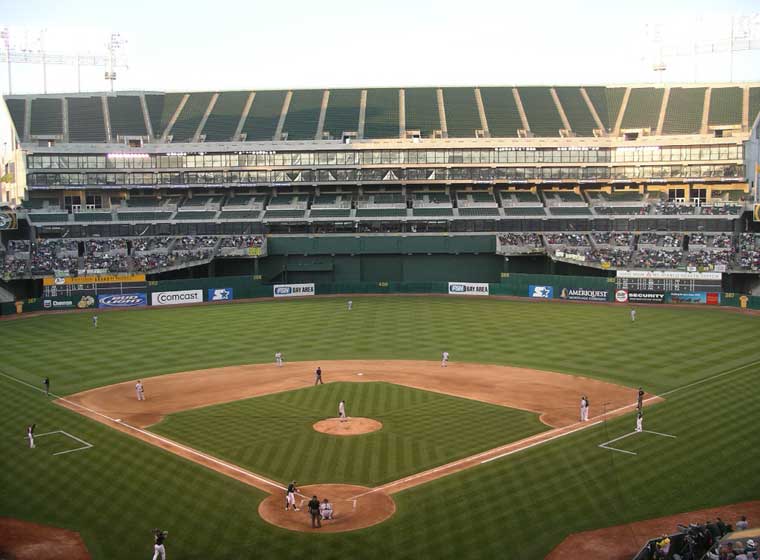
McAfee Coliseum Footnotes - Facts & Figures
| ||||||||||||||||||||||||||||||||||||||||
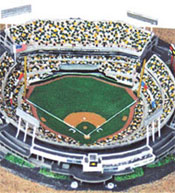
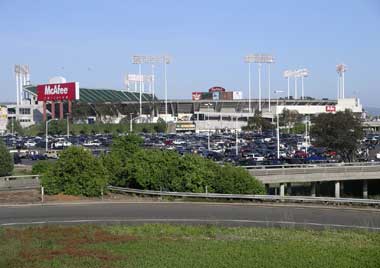
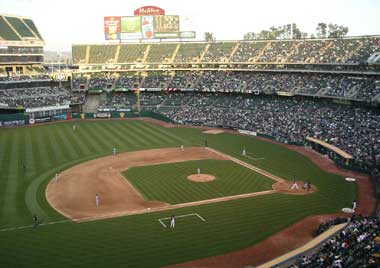
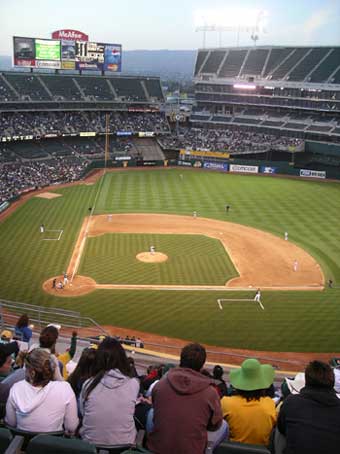 Normally there are steps or escalators that take fans from ground level to the “cheap seats.” But in Oakland the only way to get to the third deck (known as the view) is to navigate from field level through the second (plaza) level to find the only steps that takes fans to the third deck.
Normally there are steps or escalators that take fans from ground level to the “cheap seats.” But in Oakland the only way to get to the third deck (known as the view) is to navigate from field level through the second (plaza) level to find the only steps that takes fans to the third deck.

